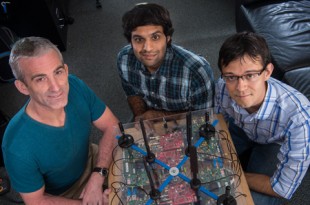Experts create multiuser, multiantenna scheme to make most of UHF band
Rice University wireless researchers have found a way to make the most of the unused UHF TV spectrum by serving up fat streams of data over wireless hotspots that could stretch for miles.

Rice University's Wireless Network Group has created a multiuser, multiantenna transmission scheme for UHF, a portion of the radio spectrum that could be useful for broadband Internet service in rural areas.
In a presentation Sept. 9 at the Association for Computing Machinery’s MobiCom 2014 conference in Maui, Hawaii, researchers from Rice’s Wireless Network Group unveiled a multiuser, multiantenna transmission scheme for UHF, a portion of the radio spectrum that is traditionally reserved for television broadcasts.
“The holy grail of wireless communications is to go both fast and far,” said lead researcher Edward Knightly, professor and chair of Rice’s Department of Electrical and Computer Engineering. “Usually, you can have one or the other but not both. Wireless local area networks today can serve data very fast, but one brick wall and they’re done. UHF can travel far, but it hasn’t had the high capacity of WiFi.
“This provides the best of both worlds,” he said of the new technology.
Rice’s technology combines several proven technologies that are already widely used in wireless data transmission. One of these is “multiple-input, multiple-output” (MIMO), a scheme that employs multiple antennae to boost data rates without the need for additional channels or transmitter power. In effect, MIMO allows for a larger wireless “pipeline,” and the technology is standard in the latest generation of wireless routers and networking equipment.
Parts of the UHF spectrum were opened after the recent switch to digital television, which has a smaller broadcast footprint than analog TV. UHF is often referred to as the “beach front” portion of the wireless spectrum because the signals travel for miles, and one popular idea for the liberated portion of the spectrum is for “open” wireless access points like those used for today’s WiFi hotspots. Using UHF for broadband Internet is particularly appealing for rural areas where wired brandband is unavailable.
“When comparing UHF and WiFi, there’s usually a tradeoff of capacity for range or vice versa,” said Rice graduate student Narendra Anand, the lead author of the new study. “Imagine that the WiFi access point in your home or office sends data down a 100-lane highway, but it’s only one mile long. For UHF, the highway is 100 miles long but only three or four lanes wide. And you cannot add any lanes.

Researchers used the Rice Wireless Network Group's popular "wireless open-access research platform" to build the world's first open-source multiple-input, multiple- output" test system capable of serving multiple users over UHF.
“To be able to leverage the best characteristics of the UHF band, we need to be able to efficiently use the lanes that we have,” Anand said. “One way to do that is with multiuser MIMO, a multiantenna transmission technique that serves multiple users over the same channel simultaneously.”
Knightly, Anand and Rice graduate student Ryan Guerra designed the first open-source UHF multiuser MIMO test system. Based on Rice’s “wireless open-access research platform,” or WARP, the system allowed the team to perform a side-by-side comparison of multiuser MIMO for UHF and for both 2.4 gigahertz and 5.8 gigahertz WiFi.
“Based on over-the-air experiments in a range of indoor and outdoor operating environments, we found that UHF-band multiuser MIMO compared favorably and produced high spectral efficiency as well as low-overhead wireless access,” Knightly said.
This research was supported by the National Science Foundation and Cisco Systems Inc.



@William Ketai: I’d like to respond to your comments to help clarify some of the issues you raise. Disclaimer: I’m one of the authors of this work.
1. The MU-MIMO beamforming technique explored in this work is actually a method designed specifically to help mitigate interference between users. While our system currently only works optimally with itself (much like your WiFi-laptop only works with other WiFi systems and not cordless phones), we expect that the use of MU-MIMO will actually reduce the interference to other systems on average by allowing transmitters to use less power for the same performance and by better focusing power to the intended receiver.
Furthermore, while we’re on the topic of WiFi, I’d like to point out that WiFi, Bluetooth, and other unlicensed devices currently feed an industry worth hundreds of billions of dollars worldwide. Each of these devices has built-in mechanisms to detect-and-avoid or co-exist with other unlicensed devices, and this approach has proved quite successful.
2. Addressing your concern about security: we’ve only developed a new radio layer (called a PHY/MAC layer). Existing techniques for data encryption and user authentication used in WiFi and cellular networks can and should be applied on top of our technology. Going back to the highway metaphor: we’re making the highway longer and wider, but you as a user should still drive down that highway in an armored car.
All wireless communications have a reasonable expectation to privacy under US and European law, and the UHF band is no more or less secure than any other radio frequency. Remember Google being sued for its Streetview cars recording unlicensed WiFi transmissions?
3. And finally, regarding television broadcasters switching channels, it’s true that unlicensed UHF devices are “secondary” users and must vacate channels occupied by “primary” TV broadcasters. However, broadcast TV stations turn on and off on the order of months (very slowly) and almost never change their broadcast frequency so it’s very easy to predict and adapt to.
The portions of Europe, the rural US, and developing countries that stand to benefit most from a low-cost, high-performance broadband system also have 100s of MHz of free UHF spectrum available. That’s more than enough to build a high-speed system as we’ve proposed, and also adapt to a few more broadcast TV stations.
I have no doubts that the system would be able to deliver as described. BUT there will certainly be a lot of inintended consequences if it is put into use. The first will be interference between users, since unlicensed operations are not protected from it, and it will certainly be unlicensed. The second consequence will be that the data will not be secure, and so it will be looked at by others. After all, unlicensed transmissions have no rights to privacy. Third, these frequencies will be subject to new television stations appearing, and suddenly the frequency is no longer free, but instead it is licensed to others, leaving the data users with no right to use it, and a legal obligation to not use it. So I would avoid spending any money on such a product, or sending any dtat that I considered private.